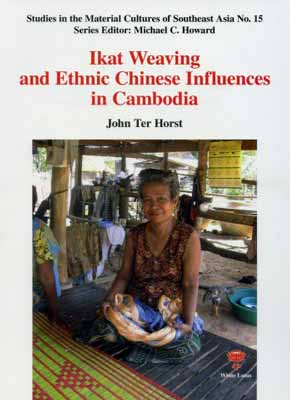-

Argentina
-

Australia
-

Austria
-

Bangladesh
-

Belgium
-

Bhutan
-

Brazil
-

Bulgaria
-

Cambodia
-

Canada
-

China
-

Croatia
-

Czechia
-

Denmark
-

Estonia
-

Finland
-

France
-

Germany
-

Greece
-

Hong Kong
-

Hungary
-

India
-

Indonesia
-

Iran (Islamic Republic of)
-

Ireland
-

Israel
-

Italy
-

Japan
-

Lao People's Democratic Republic
-

Luxembourg
-

Malaysia
-

Mexico
-

Morocco
-

Myanmar
-

Netherlands
-

New Zealand
-

Nigeria
-

Norway
-

Oman
-

Pakistan
-

Philippines
-

Poland
-

Portugal
-

Qatar
-

Republic of Korea
-

Romania
-

Russian Federation
-

Serbia
-

Singapore
-

Slovakia
-

Slovenia
-

South Africa
-

Spain
-

Sri Lanka
-

Sweden
-

Switzerland
-

Taiwan
-

Thailand
-

Turkey
-

United Arab Emirates
-

United Kingdom
-

United States of America
-

Vietnam
Ikat Weaving and Ethnic Chinese Influences in Cambodia
Bayon New Perspectives
Ikat Weaving and Ethnic Chinese Influences in Cambodia
- By: Ter Horst, John
Studies in the Material Cultures of Southeast Asia No. 15 Series Editor: Michael C. Howard
It is said that the contemporary Cambodian silk industry is centuries old and can be traced back to the 12th century courts of Angkor. The hand-woven ceremonial dress, the sampot hol, is even considered a national costume and provides the war-stricken Cambodians great pride. However, little is known about how the ikat-weaving industry is economically organized, how many silk weavers produce ikat woven ceremonial dresses, where the silk yarn comes from, and who the main customers are. The ethnic identity of the silk weavers and traders is also something of a mystery. Although Khmer and Cham involvement in the Cambodian ikat-weaving industry has been documented, the ethnic Chinese dominance of both the production and trade of silks has been neglected so far. Making use of French colonial archives the author fills this gap and describes under what conditions Cantonese silk weavers and traders arrived in Cambodia at the end of the 19th century. Based on ethnographic fieldwork in Cambodia he also describes under what economic, political, and cultural conditions the once humble rural silk industry grew into a global network. This network is not in the hands of the ethnic Khmer, but is dominated by Sino-Khmer (Chinese Cambodians), descendents of the 19th century Cantonese immigrants.
 Standard Delivery
Standard Delivery
10 - 14 days
USD$ -
| PUBLISHER: | White Lotus Press |
| ISBN: | 9789744801685 |
| AUTHOR | Ter Horst, John |
| RELEASED | 2011-06-17 |
| Bangkok, 2011 | |
| WL CODE | E22652 |
| SIZE | 111 pp., 21 pp. illus. 16 pp. in col., 1 map. 210 x 295 mm |
| BOOK WEIGHT | 0.440 Kg |
| PACKING WEIGHT | 0.200 Kg |
RECOMMENDED CATEGORIES
OTHER BOOKS
Other books you might be interested in.
JUST IN CASE
We save it for you. These are books you just viewed.








 Books by Category
Books by Category Back
Back
 ADD TO CART
ADD TO CART






